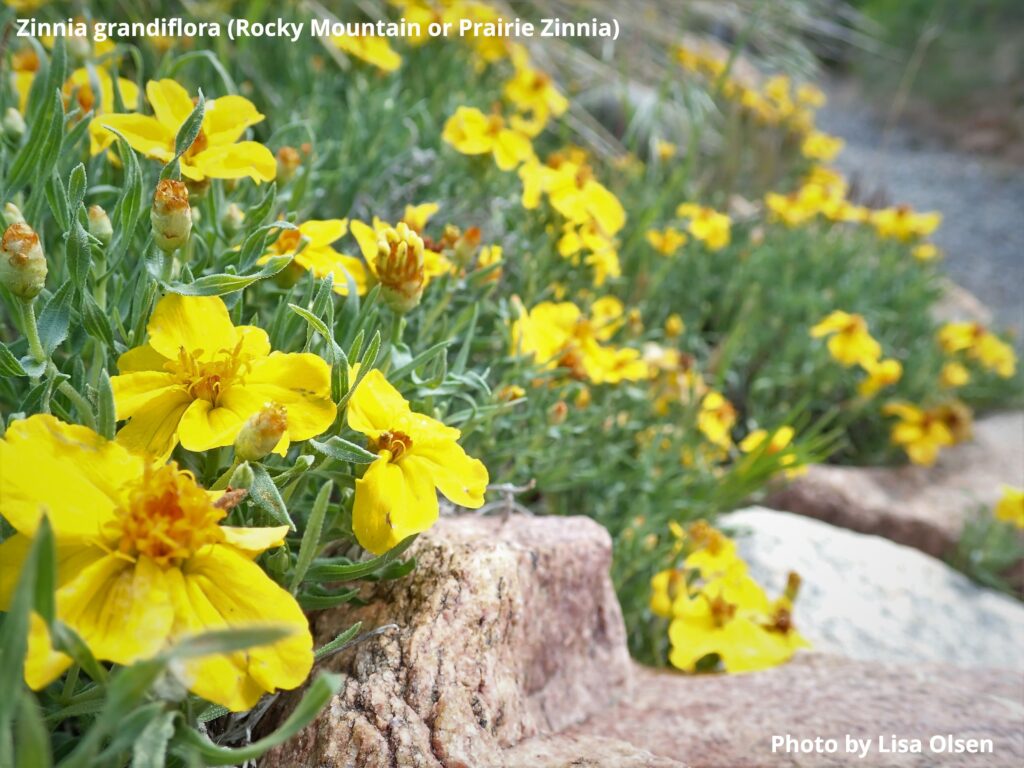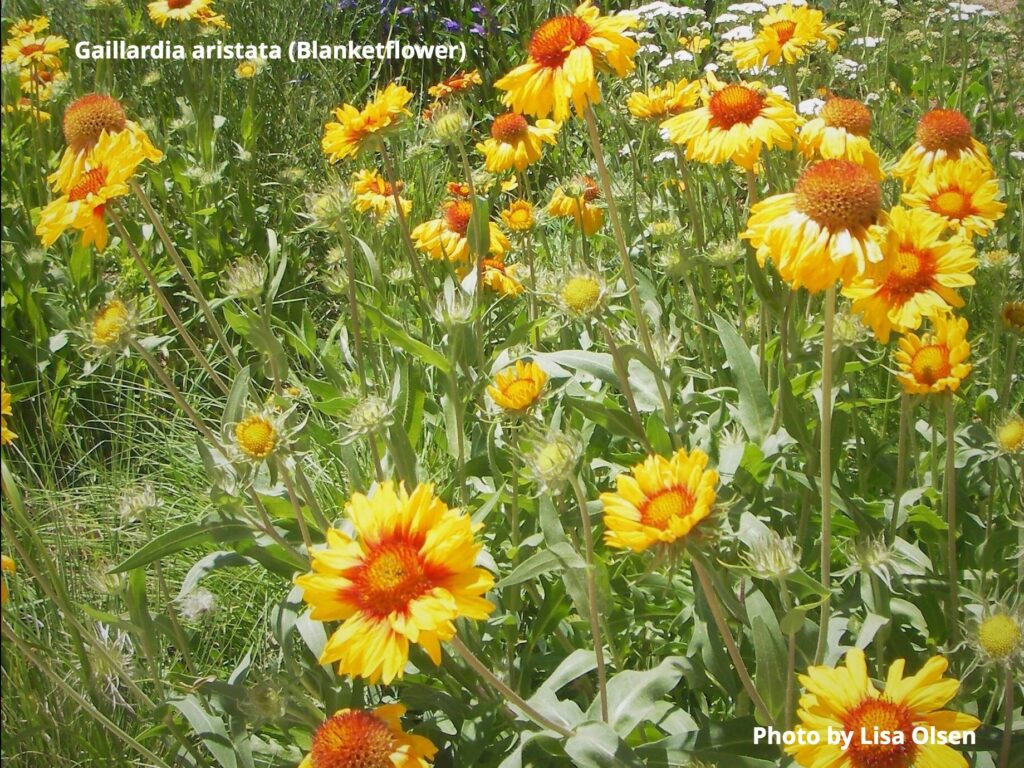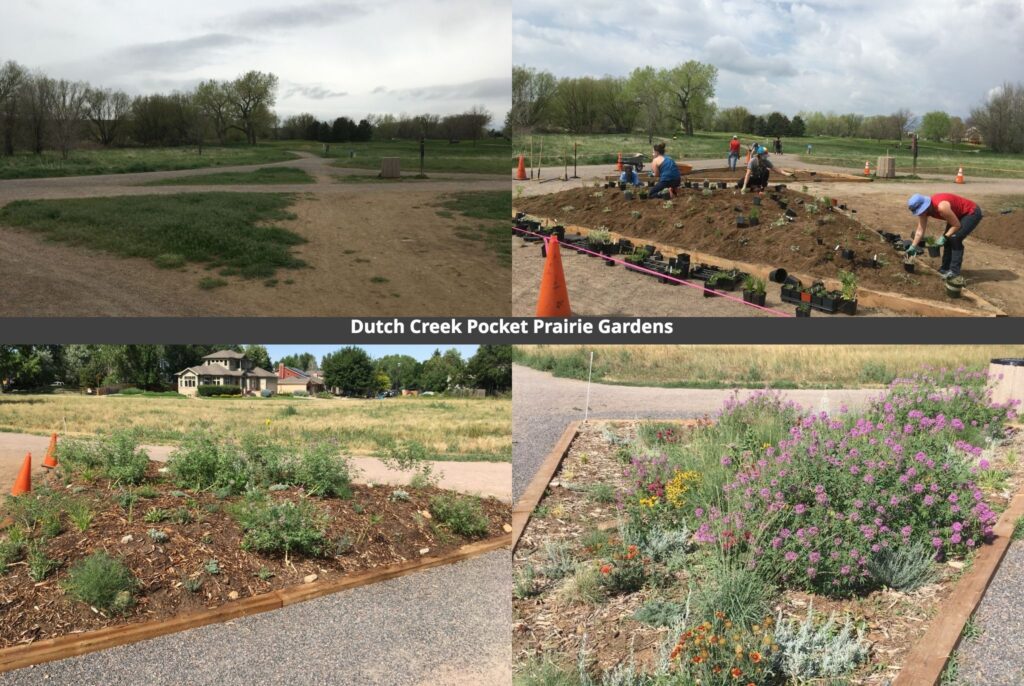By Deb Lebow Aal
Pocket Prairie is not a new term, but if you follow many sustainable gardening websites and blogs, like I do, it is suddenly everywhere. What is the buzz about?
Well, as you know, the Front Range, and much of the Midwest was prairie – short and long grass prairie. If we are native plant advocates, often our goal is to bring the prairie back. We are planting lots of native grasses and Blanket Flower (Gaillardia) and Prairie Zinnia (Zinnia grandiflora). One could argue, though, that we are not going to bring the prairie back to its original state – urban and suburban landscapes are not going away, and it remains to be seen if we can recreate what is a highly complex ecosystem. But, that doesn’t mean we shouldn’t try to restore what we can.


However, if you build it, they will come. One stand of Gaillardia will bring some pollinators in. Somehow, and this always amazes me, those specialized pollinators find the native plants they need. But we can do better than that. We can put in pocket prairies, which sounds like something we each can do. Pocket prairies are small areas emulating what the prairie looked like. They can be very small, but the bigger the better. So, instead of planting random native plants in the middle of your established non-native flower beds, the idea is that we take a portion of our landscape, and dedicate it to native prairie plants.
Why do this? Well, at the risk of a highly controversial statement, gardens are already problematic. When we make a garden, we have taken plants out of their natural environment, or their “culture,” and plopped them into an arrangement of our making. I find this creative, and I’m guessing you do, too. However, I understand that I am not recreating nature; I am creating something I find aesthetically pleasing and hopefully benefitting pollinators and other creatures in some way. But, nature has a lot to teach us. As Brian Vogt states in his book “A New Garden Ethic, “We barely understand a prairie’s culture, a complex structure formed over countless generations where mutualism and exclusion create healthy and resilient ecosystems above and below the soil line.”1 With pocket prairies, we are actually trying to recreate a tiny piece of native ecology, knowing of course that it is very hard to actually do what nature does. We are doing this to sequester carbon, and provide an area that actually benefits wildlife. Once established, a pocket prairie will also be highly resilient and drought tolerant.
And, it is a pocket prairie, not a pocket prairie garden. The term garden implies to me that it is for human use. We are always looking first at what humans want – even pollinator gardens are what humans want. We want more butterflies and hummingbirds for us to see. With the pocket prairie, we attempt, hard as it may be, to let these plants do what they want. Native plants, as you know, will wander. You may first design this to have the smaller plants up front, and the larger in back, and the yellow with the purple, but they will go where they want to go. So, although these pocket prairies can be “designed,” they should be more like what you see when you hike. More “natural,” which is to say, less designed. That’s actually freeing, I think. It’s a different aesthetic than a garden. And, it’s gorgeous (okay, that’s human-centric, I know).

Considerations
- Pocket prairies could be described by what Steve Roels, Senior Natural Resource Resource Specialist for the town of Louisville, CO, has coined as “chaos gardening.” Personally, I love this phrase and am now adopting it for my yard. Again, it’s a freeing approach and a different aesthetic from the garden design we normally see.
- Pocket prairies will require maintenance in the form of weeding, but of course, all gardens require maintenance.
- Some people mow their pocket prairies, or meadows, once or twice a season, but that’s a heck of a lot less than mowing a lawn.
- Pocket prairies are not an area of your landscape that you should walk on.
- Initial preparation of the site can be labor intensive.
How to Create a Pocket Prairie
If you’re taking out grass to put in a pocket prairie, I highly recommend you read this Wild Ones Front Range article on lawn removal, or this xerces.org article on organic site preparation. And, if you want to amend your soil, there are websites for that as well; however, for native plants, I do not amend my soil. Steve Roels, who has installed pocket prairies in the Dutch Creek Open Space in Louisville, opted for two different planting areas – one on mounded soil, and the other in depressions. It remains to be seen which plants will do better. I’m betting on the depressions.
Steve opted for plants native to Boulder County for these prairies. He planted 23 species from the middle of the range. Refer to this Guide to the Dutch Creek Pocket Prairies for more information on what he did and a list of the species he used. Generally, prairies are dominated by grasses and forbs. This plant list (in the guide linked above) is NOT exhaustive, but just a start. A shameless plug for an upcoming Wild Ones’ Front Range program – Steve Roels will be presenting on Pocket Prairies in November, 2021
Another example of a Pocket Prairie is the demonstration project at Depot Park in Englewood. Danna Liebert, a Wild Ones Front Range Chapter Board Member, has worked tirelessly with Englewood Parks and Recreation to create an example of a Pocket Prairie. It is in its initial phases, but worth a visit to see some of the plants listed above. See below under our Volunteer Opportunities to learn more about and get involved with the Depot Park project.
Think it’s worth a try? Carve out a few feet of your garden or landscape to start a pocket prairie and you’ll be on your way. If we all did that, we would make a dent in the Homegrown National Park, a grassroots call-to-action to restore biodiversity, that Doug Tallamy has started. Please, if you have a pocket prairie, email your photos to Wild Ones Front Range! We will be highlighting these areas in future newsletters. Thank you!
- I highly, highly recommend this book! A New Garden Ethic, by Brian Vogt, Page 57 ↩︎
